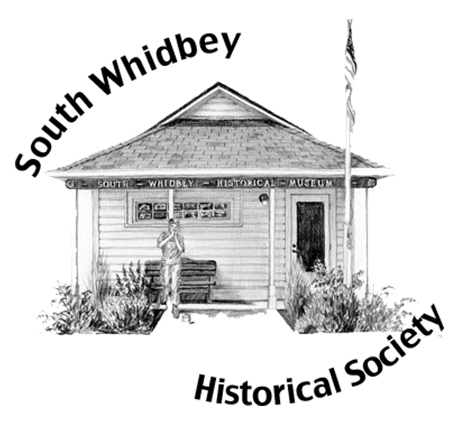As South Whidbey communities began to form, the pervasive, indomitable Pacific Northwest forest continued to deter transport by road. For the longest time, travel by boat was the most practical method. As settlers fought the narrow, dusty wagon trails to get to church, it is no wonder that each Sunday morning those faithful pilgrims of the Maxwelton valley began to think of alternatives to the Methodist church in Langley, and the Lutheran church in old Clinton.
In 1909, the community of Maxwelton decided that it had suffered long enough, and raised $800 to construct their own church. It is a church that was truly built by the community. For Peter Howard Mackie, that $800 would blossom into the much repeated classic American story of barn building and church building. It was probably Mackie’s sawmill*, beneath the bluff on the way to the beach, that milled the lumber, that would form the sheltered-structure, which would become the Little Brown Church.
“Bossy” Mackie
Sometime in the 1890’s, Peter Howard Mackie married Ada Hally in Oceola, Nebraska. At that time, the Alaska Gold Fever contagion was sweeping the country, and Peter Mackie had not been immunized. He was only cured of the Klondike disease when he looked out on the destruction the great Seattle fire had caused. It was obvious that a construction boom was in full swing to replace all the burned out buildings, and this was actually a great opportunity for a skilled carpenter like Peter Mackie.
The Mackie’s settled in the Ravenna district near the University of Washington, and Peter went to work building student housing until disaster struck. The University of Washington complained to Peter and Ada that their cow, “Bossy”, was grazing on University grounds. It was time to move.
Out of the four Scottish Mackie brothers, Theodore had actually built a home two miles north of Scatchet Head on Whidbey Island. Once the other two brothers, Herbert and David, had made it out from Oceola, it was just a matter of time and opportunity before the four of them were able to put down roots as productive farmers on South Whidbey. The opportunity arrived in 1905, and the Mackies purchased a 900-acre parcel which had been the old Luther Moore property. David, the more musical brother, christened their property “Maxwelton” after his favorite Scottish song.
In July of 1905, “Bossy” Mackie was pushed off the deck of the stern-wheeler Skagit Queen as the ship lay anchored off Maxwelton beach. After a number of protesting “moos,” she made it ashore in good form. Peter’s brood would stay at Theodore’s home on the hill until they were settled in at the beach cottage. As Ada, now six months pregnant, began the trudge up the hill to Theodore’s house, Peter urged her to sit on the sled, or skid, and have the horses pull her up. As the horses pulled, they jerked, and Ada toppled off the skid. Peter gently got her back on the skid and safely up to Theodore’s home. Three months later, Ada gave birth to Albert, who would bear the nickname “skid” for the remains of his life. Ada gave birth to a total of twelve children, including twins.
The Bohnke’s & The Little Brown Church
Henry Bohnke owned 15 acres of farmland above Maxwelton on Sills Road. Henry was a German born bachelor who had settled on Whidbey Island in 1909, having worked for the Great Northern Railroad in Everett. His days of being a bachelor were numbered once he met the new teacher of the Phinney School in Clinton. Although Amelia Fiske was only a teen-ager, she came from an established island family that had settled on Prosperity Ridge, and for which Fiske Hill was named after.
It was at the Little Brown Church where they met–and Henry fell in love. Henry knew he was going to have to work hard to make the right impression if he had any hope of getting the answer he desired. Besides that, the Fiske family was highly respected on South Whidbey. After much thought and deliberation, and with some measure of melodrama, he decided to display his greatest asset – his skill at the trumpet. On one moonlit evening in front of the Fiske home, the Fiske family was shocked and startled to hear trumpet music coming from their driveway. There, dressed in his best suit, was Henry coming down their lane blasting out “Hold the Fort, I’m Coming,” on his trumpet. They were married in 1912 and had five children. Henry died in 1952. Amelia lived almost sixty years in the house she first entered as a bride. She passed away in 1968.
The Little Brown Church Today
George and Lila Mills purchased the A-frame-style building at Maxwelton and French roads in 2008. George’s great-grandparents were part of the original five-member Board and the first funeral service in the church was conducted for his great-grandfather, John W. Grubb.
The church underwent various alterations through the years, and was painted gray in 1993. It was last used as a church in 2006, and was put up for sale in 2007.
The current building contains a fellowship hall in the basement, and 18 pews in the sanctuary, which was part of the original church. A bell purchased in 1934 for $10 from a local school district and attached to the church roof is still there, George Mills said.
His latest project is to get in touch with as many people as possible who were married in the church through the years.
In 2011, the 100-year-old icon of the Maxwelton Valley became home to Whidbey Bible Fellowship, a Bible study group of South End residents formed earlier this year. The group meets at 10:30 a.m. in the community room of the church at Maxwelton and French roads.
*Reference phone con with Lila and George Mills of Dec 2, 2015 – Some doubt that P.H.Mackie milled the timber.
Recommended photo: Volume II, Top photo, page 96.


